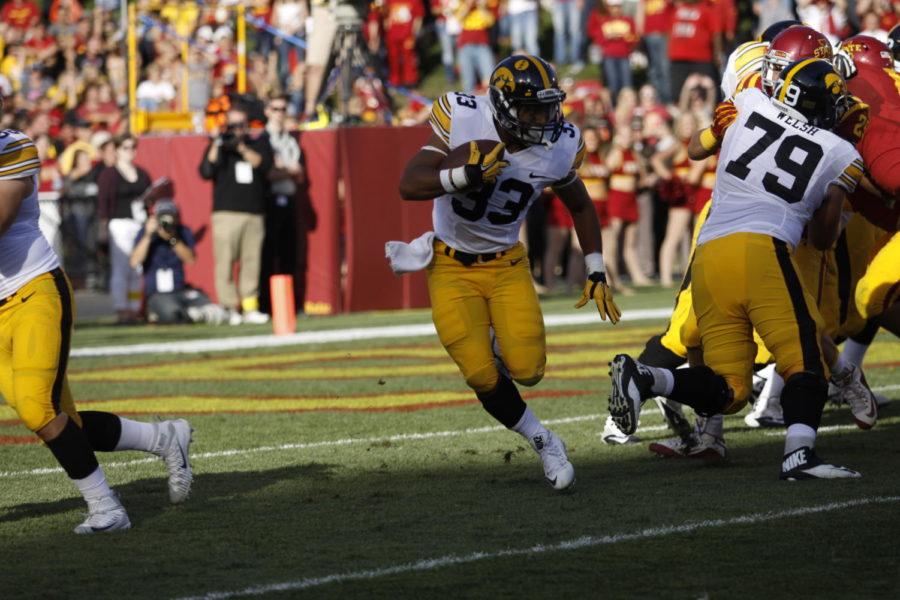Hawkeyes run over and away from ISU defense, capture Cy-Hawk trophy
University of Iowa’s Jordan Canzeri runs through a gap Saturday during the second quarter at Jack Trice Stadium. The Cyclones led the Hawkeyes 17-10 going into the half.
September 14, 2015
The Cyclones fell 31-17 to the Hawkeyes on Saturday at Jack Trice Stadium in a Cy-Hawk matchup that wasn’t nearly as lopsided as the final score — except in one crucial area.
Iowa State (1-1, 0-0 Big 12) mustered only 63 rushing yards, the second time in two games the team has failed to eclipse 80 yards on the ground. Meanwhile, Iowa (2-0, 0-0 Big 10) tore through the ISU run defense to the tune of 260 rushing yards.
“It’s not a running back problem as far as the running game is concerned,” said ISU coach Paul Rhoads. “You’ve got to give people space to run the football, and we didn’t do it.”
And for the part of the ISU offense, particularly the ISU offensive line, which was dominated by the Hawkeyes’ defensive front in the second half, it really was that simple.
An inability to run the ball on first and second down put the Cyclones in predictably untenable 3rd-and-long situations throughout the game.
Even with the exit of Drew Ott — Iowa’s most fearsome defensive lineman — who left the field in first quarter with an injury, the Hawkeye pass rushers were able to pin their ears back and pressure ISU quarterback Sam Richardson consistently, totaling four sacks throughout the afternoon.
An ISU offense that produced 244 yards and 17 points in the first half amassed only 66 yards on 31 plays and zero points in the second half, losing the time-of-possession battle by more than six minutes, which directly impacted the defense, zapping its energy as the game wore on.
Where the defense proved the weakest, however, was in its inability to stem the big plays engineered by UI quarterback C.J. Beathard, a problem that started in the second quarter.
“They got half of their [260] rushing yards off quarterback scrambles,” said ISU linebacker Jordan Harris, who recorded seven tackles and a fumble recovery. “It’s just blown assignments. I think it was more of a mental breakdown.”
Applying pressure in the passing game wasn’t an issue at any point for the Cyclones, who tallied three sacks against Iowa and already have nine on the young season — five of them from defensive end Dale Pierson — after amassing only 15 last season.
But the resurgent pass rush out of the new-look, 3-4 scheme the Cyclones continued to employ most of the afternoon can be a double-edged sword.
Trailing 10-3 in the middle of the second quarter, the Hawkeyes started their drive from their own 7-yard line. Beathard dropped back to pass when Pierson captured the edge, getting his hands on Beathard in the end zone.
Even as Pierson gripped his ankle, Beathard danced his way back to the 1-yard line, avoiding a safety that would have extended the Cyclones’ lead to 12-3 and given Iowa State the ball back.
Iowa State applied pressure again the next play, but the result was vastly different.
Beathard floated around his end zone on 2nd and 16, looking for an open receiver. Unable to locate an open target, he stepped up to avoid the rush and found a huge lane.
And 44 yards later, the Hawkeyes had snatched the momentum in a game they would soon tie up.
“We get so much pressure, it’s a blessing and a curse,” said ISU linebacker Jarnor Jones, who had eight tackles, including two tackles for loss and a sack. “It flushes the quarterback up in the pocket, which allows him [to run] on you and that’s the thing — it’s either hit or miss with the blitz or the rush.
“When we get a sack, it’s not a problem. But see, when we don’t get a sack, it allows the quarterback to see downfield and have open gaps.”
Beathard ripped off another run near the end of the half, this time for 57 yards, and added a 48-yard completion to wideout Matt Vandeberg in the fourth quarter — the three plays combining for more than one-third of the Hawkeyes’ total offense on the day.
“That’s why you can’t get complacent in this game,” Harris explained. “You can be up 14 points and still lose. Crazy stuff happens in [the Cy-Hawk] game.”
Only one of Iowa’s three big plays contributed directly to a scoring drive, but each drastically changed the field position and momentum battles, and all had an undeniable psychological effect on the ISU defense.
“We gave up some plays that broke down, and we didn’t tackle very well,” Rhoads said. “There was too much arm tackling that took place tonight.”
Whether the problem was schematic or existed in the execution of that scheme was unclear even to the ISU defenders on the field.
Iowa State avoided the 4-3, which would have brought an extra lineman in and provided more strength at the point of attack, in favor of the 3-4, which features an extra linebacker.
“Honestly, I couldn’t tell you,” Jones said. “I know that we covered the quarterback scramble throughout the whole week. […] I could tell you that [the problem] was scheme, but I’m not sure. We have to be more patient and stay at home.
“We’ll get it right.”
The Cyclones will have to get it right sooner rather than later, as a staunch Big 12 schedule is fast approaching.
















